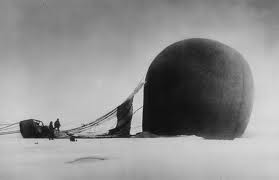At exactly 2.30pm on 11 July, 1897, a gigantic silk balloon could be seen rising into the Arctic sky above Spitzbergen. Inside the basket were three hardy adventurers, all Swedish, who were taking part in an extraordinary voyage.
Salomon Andrée was the instigator of the mission. Charismatic and confident, he managed to persuade Nils Strindberg and Knut Fraenkel to accompany him on his historic balloon flight over the North Pole.
Andrée was confident of success. His balloon, the Eagle, used advanced hydrogen technology and he had developed a complex steering system using drag ropes.
 |
| Salomon Andree |
A disastrous test flight suggested that Andrée’s confidence was seriously misplaced. The much vaunted rope-steerage system had numerous glitches and hydrogen was found to be seeping out of the balloon’s eight million little stitching holes.
The expedition ought to have been abandoned before it even took off. But Andrée overruled all objections and the launch was scheduled for the second week of July. The problems began within minutes of getting airborne. As the balloon drifted across the sea to the north of Spitzbergen, it was weighed down by the weight of the drag ropes - so much so that the balloon actually dipped into the water.
Andree jettisoned 530 kilograms of ropes, along with 210 kilograms of ballast. This lightened the balloon so much that it now rose too high: the change in air pressure caused huge quantities of hydrogen to escape through the little stitching holes.
Andrée remained optimistic, releasing a carrier pigeon with the message ‘All well on board.’
This was far from true. The first ten hours of troubled flight were followed by 41 hours in which the balloon - soaked in a rainstorm - flew so low that it kept bumping into the frozen sea.
 |
| Knut Fraenkel |
The Eagle eventually crash-landed onto the sea-ice some fifty hours after taking off from Spitzbergen. No one was hurt, but it was clear that the balloon would never fly again. The men were stranded, many miles from anywhere and lost amidst an Arctic wilderness. They were well equipped with safety equipment, including guns, sleds, skis, a tent and a small boat. Yet returning to the relatively safety of Spitzbergen involved a gruelling march across shifting, melting ice.
The men spent a week at the crash site before setting out on their long hike. They had a reasonable quantity of food - meat, sausages and pemmican - but found it impossible to transport so much weight across the rucked-up ice. Much of the food had to be abandoned: henceforth, they were to rely on hunting for their survival.
They left their makeshift camp on 22 July and initially headed for Franz Josef Land. But the ice soon became impassable so they headed instead towards the Seven Islands, a seven-week march, where there was known to be a depot of food.
 |
| Over the ice |
The terrain was so gruelling that they were reduced to advancing on all fours. But they eventually reached a place where the sea-ice had melted sufficiently for them to use their collapsible boat.
‘Paradise!’ wrote Andrée in his diary. ‘Large even ice floes with pools of sweet drinking water and here and there a tender-fleshed young polar bear!’
Their passage soon became impassable once again, forcing them to change direction. Aware that winter would soon be upon them, they built a hut upon an ice floe. But the ice broke up beneath them and they were lucky to struggle ashore onto desolate Kvitoya island.
 |
| Supper: polar bear |
‘Morale remains good’, reported Andrée. ‘With such comrades as these, one ought to be able to manage under practically any circumstances whatsoever.’
It was the last coherent message he ever wrote. Within a few days, all three men were dead. Their fate was to become one of the great mysteries of Arctic exploration.
What happened to them? They had shelter, food and ammunition and ought to have been able to keep themselves alive. In the absence of any news, the world’s media began to speculate as to what had happened.
 |
| Nils with sledge |
It was not until 1930 - fully 33 years after the men were lost - that their remains were finally found. Far from answering questions, the discovery of their bodies only deepened the mystery. The most plausible theory is that the men died of trichinosis, contracted after eating undercooked polar bear meat. They certainly had the symptoms of the disease and larvae of the trichinella parasite were found in a polar bear carcass at the site. But recent scientific evidence has thrown doubt on this conjecture.
Other suggestions include vitamin A poisoning from eating polar bear liver, lead poisoning from the food cans or carbon dioxide poisoning from their primus stove.
Their diary entries reveal that by the time they struggled ashore they were living off scanty quantities of canned goods from the balloon stores, along with portions of half-cooked polar bear meat.
They were suffering from foot pains and debilitating diarrhoea and were constantly cold and exhausted. Indeed they were so weary on their arrival at Kvitøya Island that they left much of their valuable equipment down by the water's edge.
 |
| Remains: 1930. |
Nils Strindberg, the youngest, was the first to die. His corpse was found wedged into a crack in the cliff. Analysis of his clothing suggests he was killed by a polar bear.
The other two men seem to have weakened dramatically in the days that followed Strindberg’s death. As the Arctic winter struck in earnest, they lost the will to live.
It will never be known how many days they survived in their makeshift Arctic shack. By the time they were eventually found, all that remained was their diaries, a few spools of film (now developed) and a heap of bleached bones.



No comments:
Post a Comment